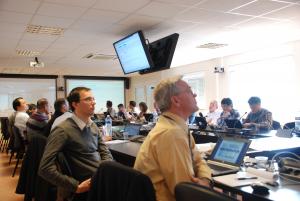One-stop shop: Engineering Database launched
15 Mar 2012
-
Sabina Griffith
The Engineering Database passed its first test at this week's Configuration Management Working Group meeting organized by Chul Hyung Lee, ITER Configuration Control Manager.
On 29 February, a new tool was launched that will help to improve and facilitate the way a huge amount of data is managed within the ITER project.
The genesis of the Engineering Database—a project led by Ken Blackler, head of ITER's Assembly & Operations Division—involved collaboration over the past year between ITER's Project Information Section (IT), the Design Office, Technical Integration Division, and Department of Safety, Quality & Security, as well as extensive participation by representative end users.
"The goal of the Engineering Database is to create a one-stop shop where all the ITER data that you can imagine is stored, organized and updated in an automated manner," explains Stefano Chiocchio, head of ITER's Technical Integration Division. "Before we launched this database I spent much of my days answering emails from colleagues and collaborators seeking technical information such as the temperature in a particular room. Finding the answer meant a time-consuming search for the right document, and further time spent verifying that the information was up-to-date. The new Engineering Database will put an end to this confusion."
The Engineering Database will allow all 7000 users and customers who need to put their hands on ITER data fast access to answers. In its final version, it will offer complete, lifecycle documentation for the project.
The Engineering Database will allow all 7000 users and customers who need to put their hands on ITER data fast access to answers. In its final version, it will offer complete, lifecycle documentation for the project.
"In the beginning we thought we might be able to work with a commercial solution, and not 'reinvent the wheel,'" says Vijay Patel who, together with Carlo Capuano, was in charge of the technical development of the database. "But the fact that contributors are situated all over the world makes the ITER case a unique one. We dropped the idea of a commercial solution and developed our own ... not always an easy task in this multinational, complex project!"
A special feature of the Engineering Database is its direct link to the Design Office's ENOVIA database that stores CAD models. Whenever a drawing or a model is updated in ENOVIA, the data in the Engineering Database is updated in parallel. A special viewing tool will also allow the user to open the required model or drawing directly.
The database passed its "baptism by fire" this week during the Configuration Management Working Group meeting. Each Domestic Agency had sent technical officers to hear how the Engineering Database will improve future cooperation. All agreed that the implementation of the database, in close collaboration with the Domestic Agencies, will help to clarify the interfaces that impact the Domestic Agencies and their suppliers.
The challenge ahead? Uploading the millions of pieces of data as ITER designs are being completed and the construction work begins ...


